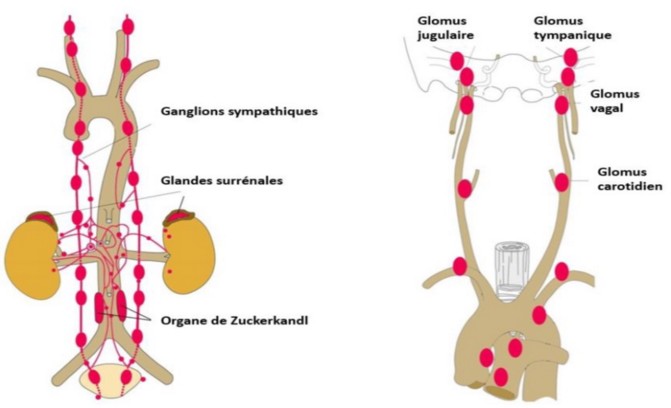Paragangliomas are neuroendocrine tumors of neuroectodermal origin that can develop at the expense of the:
- sympathetic nodes located along the spine; they are sometimes present in the cervical region.
- parasympathetic lymph nodes located mainly in the cervical region and the base of the skull (carotid, vagal, tympanic or jugular glomi).

These tumors can produce excess of catecholamines: they are called functional or secreting paraganglioma. This production of catecholamines can lead to high blood pressure, symptomatology suggestive of catecholamine discharge (headache, sweating, palpitations, malaise) and acute complications, especially cardiovascular. Thoraco-abdomino-pelvic paragangliomas are functional in about 85 % of cases. Cervical paragangliomas, most often of parasympathetic origin, are functional in only 10 % of cases.
There are familial forms of paragangliomas:
- PGL1: mutation of the SDHD gene (11q23) [MIM 168,000], familial paraganglioma type 1, with or without deafness
- PGL2: mutation of the SDHAF2 or SDH5 gene (11q13) [MIM 601 650], familial paraganglioma type 2
- PGL3: mutation of the SDHC gene (1q23.3) [MIM 605 373], familial paraganglioma type 3
- PGL4: mutation of the HBDS gene (1p36.13) [MIM 115 310], familial paraganglioma type 4
- PGL5: mutation of the SDHA gene (5p15) [MIM 614 165], familial paraganglioma type 5
- PGL6: mutation of the SLC25A11 gene (17p13) [MIM 618 464], familial paraganglioma type 6
- PGL7: mutation of the DLST gene (14q24) [MIM 618 475], familial paraganglioma type 7
- mutation of the FH gene (1q43) coding for fumarate hydratase
- mutation of the KIF1BP gene (1p36.22) [MIM 171 300],
- mutation of the TMEM127 gene (2q11.2) [MIM 171,300]
- somatic mutation of the MAX gene (14q23.3) [MIM 171,300]
- mutation with gain of function of the EPAS1 gene (or HIF2A for hypoxia-inducible factor 2-alpha) (2p21) (Pacak-Zhuang syndrome) combining early polycythemia, multiple paragangliomas (sometimes secreting), and digestive somatostatinoma (usually duodenal)
Anesthetic implications:
risk of catecholamine secretion by the paraganglioma (see pheochromocytoma); for glomic tumors, it is useful to ask the surgeon to infiltrate them with lidocaine in order to decrease the hemodynamic responses (bradycardia or even sinus arrest) during their manipulation.
References :
-
Updated: April 2022